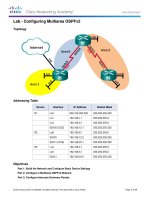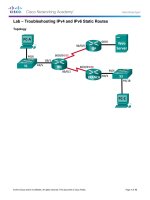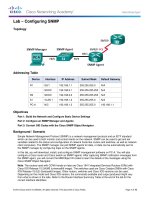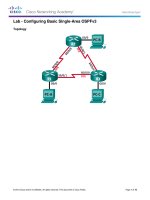14 etherchannel stackwise kho tài liệu bách khoa
Bạn đang xem bản rút gọn của tài liệu. Xem và tải ngay bản đầy đủ của tài liệu tại đây (501.94 KB, 16 trang )
Implementing VLANs in Campus Networks
Configuring Link Aggregation with
EtherChannel
BSCI v3.0—2-1
Multiple Links
• When multiple links
aggregate on a switch,
congestion occurs.
• One solution is to increase
uplink speed, but cannot
scale indefinitely.
• Another solution is to
multiply uplinks; loop
prevention mechanisms
disable some ports.
EtherChannel
• Solution to provide more
bandwidth
• Logical aggregation of
similar links
• Viewed as one logical link
• Provides load balancing
and redundancy
• Supported for switch ports
(Layer 2) and routed ports
(Layer 3)
PAgP and LACP
• Protocols to negotiate the
EtherChannel link creation
and maintenance.
• PAgP is a Cisco proprietary
protocol.
• LACP is IEEE 802.3ad
standard.
• Static EtherChannel
configuration without
protocol.
PAgP Modes
PAgP negotiates EtherChannel formation and maintenance:
• On: channel member without negotiation (no protocol)
• Desirable: actively ask if the other side can/will
• Auto: passively wait for other side to ask
• Off: EtherChannel not configured on interface
LACP Modes
LACP negotiates EtherChannel formation and maintenance:
• On: channel member without negotiation (no protocol)
• Active: actively ask if the other side can/will
• Passive: passively wait for other side to ask
• Off: EtherChannel not configured on interface
How to Configure Port Channels Using
EtherChannel
Basic tasks:
• Identify the ports to use on each switch.
• Specify PAgP or LACP protocol (optional).
• Configure channel group on interface.
– Specify a channel group number.
– Specify the mode (will set protocol).
• On (no protocol)
• Auto/desirable (PAgP)
• Active/passive (LACP)
• Configure port-channel interface.
– Access or trunk mode and other parameters.
• Verify connectivity.
Guidelines for Configuring EtherChannel
Port-channel interface configuration changes affect the
EtherChannel.
The physical interface configuration changes affect the
interface only.
EtherChannel cannot be used if SPAN is a destination
port.
All interfaces within an EtherChannel must have same
configuration.
•
•
•
•
•
Same speed and duplex.
Same mode (access or trunk).
Same native and allowed VLANs on trunk ports.
Same access VLAN on access ports.
Configure these parameters on the port-channel interface.
How to Configure Layer 2 EtherChannel
• Channel group mode options:
– On
– Active or passive (LACP)
– Auto or desirable (PAgP)
• The configuration on a port-channel interface is copied to
member interfaces.
How to Verify EtherChannel
Switch#show interfaces f0/24 etherchannel
Port state
= Up Sngl-port-Bndl Mstr Not-in-Bndl
Channel group = 1
Mode = Active
Gcchange = Port-channel = null GC
=
Pseudo port-channel = Po1
Port index
= 0
Load = 0x00
Protocol =
LACP
Switch#show etherchannel 1 port-channel
Port-channels in the group:
--------------------------Port-channel: Po1
(Primary Aggregator)
Age of the Port-channel
= 195d:03h:10m:44s
Logical slot/port
= 0/1
Number of ports = 2
Port state
= Port-channel Ag-Inuse
Protocol
=
LACP
Ports in the Port-channel:
Index
Load
Port
EC state
No of bits
------+------+------+------------------+----------0
55
fa0/23
Active
4
1
45
fa0/24
Active
4
How to Verify EtherChannel (Cont.)
switch# show etherchannel summary
Flags: D - down
P - bundled in port-channel
I - stand-alone s - suspended
H - Hot-standby (LACP only)
R - Layer3
S - Layer2
U - in use
f - failed to allocate aggregator
M
u
w
d
-
not in use, minimum links not met
unsuitable for bundling
waiting to be aggregated
default port
Number of channel-groups in use: 1
Number of aggregators:
1
Group Port-channel Protocol
Ports
------+-------------+-----------+----------------------------------2
Po1(SU)
Fa0/23(P)
Fa0/24(P)
Implementing Stackwise
Stackwise Technology
BSCI v3.0—2-12
Technology Overview
• Cisco StackWise
technology create a
unified, logical switching
architecture through the
linkage of multiple, fixed
configuration switches.
• The switches use special
stack interconnect cables
that create a bidirectional
closed-loop path.
• The bidirectional path
acts as a switch fabric for
all the connected
switches
The Master and Subordinate Switches
• Each switch is assigned
a number.
• Up to nine separate
switches can be joined
together.
• Each switch in the stack
can be a master or a
subordinate (member).
• The master switch is
elected and serves as the
control center for the
stack.
Stack Technologies
•
•
•
•
Stackwise:
•
Cisco Catalyst 3750.
•
32Gbps.
Stackwise plus:
•
Cisco Catalyst 3750E, 3750X.
•
64 Gbps.
Stackwise 160:
•
Cisco Catalyst 3650.
•
160 Gbps.
Stackwise 480:
•
Cisco Catalyst 3850.
•
480Gbps.









